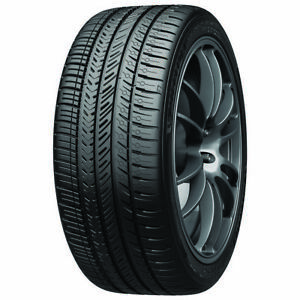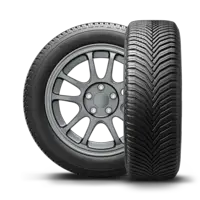Michelin’s newest high-performance tire, the Pilot Sport All-Season 4
 |
 |
So here is my two-cent worth opinion. I must admit that the CrossClimates do look cooler and they reminded me of the tires on the deuce-and-a-half I used to drive in the army, BUT they sure make her SUV ride harder, negating the amazingly comfortable luxury car-like ride of the Lexus 450h SUV, while delivering a ride that is common to most other truck-like riding SUV's. But hey it is her car and her decision. When I asked what she thought of her new tires she admitted that they "may" ride harder but she liked them because they were sportier. So if you have an SUV that needs tires but are not interested in a "sporty" ride, I would choose the Pilots or something similar from another tire maker. Now finally here is Thom Cannell's story.
Michelin's Pilot Sport All-Season 4 Tires
By Thom Cannell
Senior Editor, Technology Desk
Michigan Bureau
The Auto Channel
I’m actually quite happy when I need new tires for the family car as it provides an opportunity to learn what’s new in tire science. We at The Auto Channel have examined and reported on high performance, all-season and winter tires from a variety of manufacturers, now we test Michelin’s latest all-season, high performance tire, the Pilot Sport All-Season4.
How high is the performance? It’s fitted to the latest Corvette C8, a supercar if ever there was one. Sizes also fit many premium performance vehicles from an Audi S4, to Lexus IS, to Tesla X and S, to VW’s GTI and many more. There are, or will be soon, over 100 sizes, 31 new sizes, to fit most high-performance SUVs and sedans.
The new All-Season4 replaces the Pilot Sport All-Season 3, which has been available since 2016 and was one of the first ultra-high performance all-season tires. Michelin says that those four years between tire iterations produced a 10% improvement in snow traction, 5% better wet braking and 4% better dry braking compared to its sibling. The company says noise, comfort and wear remain similar.
As the Pilot Sport name is associated with ultra-performance tires, what does the all-season design give up? Not much, according to Michelin, and below 40°F the all-season design is wildly superior, more so as temperatures plummet. During recent winter storms, while I normally would have driven on Winter tires, with the Pilot Sports I never felt in any danger, nor did I have significant traction loss in 8-inches of snow or on glare ice. There was a somewhat noticeable difference in emergency braking traction.
Lest you scoff when tire companies say “summer-only use,” I have personally been stuck on driveways with ¼” of snow atop, unable to climb freeway on-ramps, and nearly been run over because of lack of traction from summer-only tires. Thus, while for some families a set of summer and winter tires is the rule, for others one set of all-season tires will deliver both safety and high-performance year-around.
Let’s dig into the technology of an all-season ultra-performance tire a bit. What makes them suitable for both summer and winter, their chemistry and construction, and what they give up in warm weather performance?
Tires are balloons wrapped with cord, thickened with natural and artificial rubber, and held to the wheel with a special “bead” profile that may include a fender (like that on Pilot Sport) to protect expensive alloy wheels. The surface is composed of a wrap of polymers designed for wet -and-dry traction and enhanced by treads and blocks designed to expel dirt and water for safety, unlike the no-tread tires—slicks—fitted to dragsters for maximum “rubber on the ground” traction.
This latest Michelin Pilot Sport All-Season 4 has made improvements in each of several areas:
Michelin continues to use both steel and aramid fibers in construction for strength and durability. For the new tire, the tread pattern and compounds were revised to better deliver lateral grip (cornering) by placing more rubber on the outer shoulder and the compound changed to better adhere to silica, which is added to increase grip in rain and snow. Also, for wet weather grip the tread has more sipes (cuts) to increase snow and rain traction.
After several months and a few thousand miles this is the bottom line; the Pilot Sport All-Season 4 is truly a high-performance tire with outstanding wet and dry grip and a 45,000-mile tread warranty (30k if you have run-flats). It delivers a smoother and quieter ride than the high-performance A/S tires it replaced, while delivering similar steering feel and directionality. In snow—wet-dry-deep snow—and on ice it comes close to a winter tire, but if I lived further north or deeper into the woods I’d switch to winter tires for even better snow grip.


